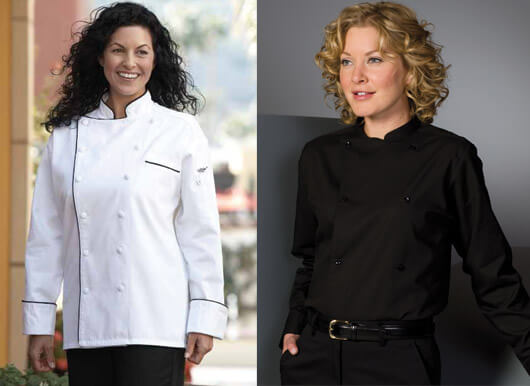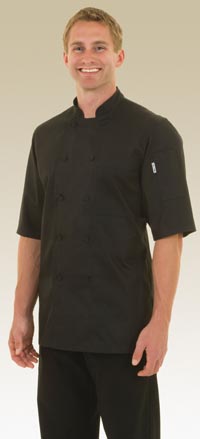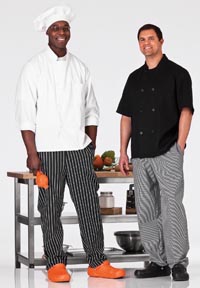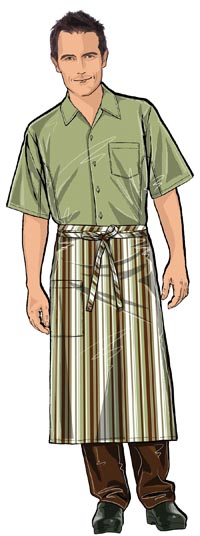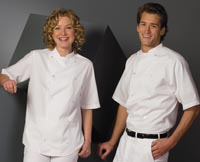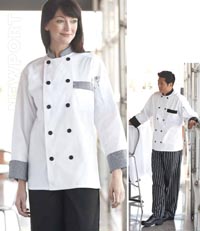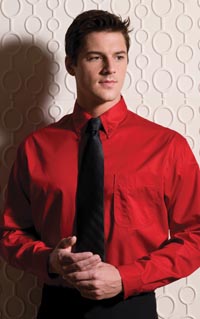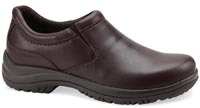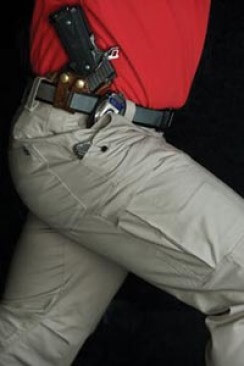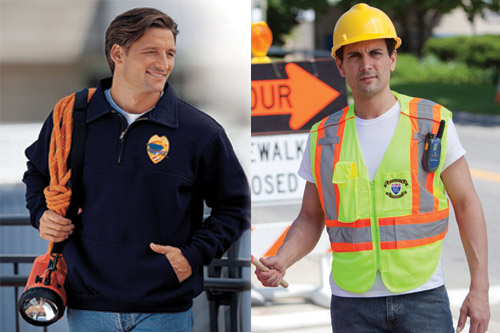|
By Jackie Rosselli
|
|
|
R emember the days when chefs were holed up in an enclosed kitchen never to be seen much less heard from? Or when going to an upscale restaurant guaranteed a quiet, refined dining experience? Not anymore. The advent of the open kitchen and the rise of the Food Network have catapulted chefs and their entourages to rock-star celebrity, with patrons clamoring for a seat as close to the drama of a bustling kitchen as they can get. A decade ago, the thought of seeing your meal prepared might have made you blanch. These days, concerns over what we eat and how its prepared have helped fuel the open-kitchen craze. Thanks to television cooking shows, diners are accustomed to peering behind the curtain, to being part of the performance. Eating out is no longer simply about food; its theater, and the open concept brings great energy to any restaurant. This of course has opened up new opportunities and a few challenges to those who supply the chef wear and hospitality industry. And there is the added challenge of the economy, where more consumers are opting to dine at home to save money. Whats the state of the chef and hospitality apparel market these days? When it comes to products and trends, whats hot and whats not in the kitchen and at the table? In short, whats going on out there? For a better understanding, weve interviewed several chef and hospitality manufacturers. Our conversations appear below. Chef Works CW: Theres a movement away from traditional chef wear, mainly due to the economy. But there are others factors in play. Todays top chefs are much more street. They want something that reflects them, not the industry. The 100 percent Egyptian cotton chef coat used to be the industrys mark of success, but if you look at the top 10 chefs today, theyre wearing something different. They want apparel that reflects who they are, and from their perspective, the Egyptian coat takes away from their personality. MTM: Ok. So Egyptian cotton is no longer the standard; it lacks the personality chefs are looking for. What are they looking for? CW: Its difficult to lump all chefs and all restaurant employees together, since there can be vast differences between venues and the regions in which they operate. To the chef, appearance is important but functionality is also a must-have, and today, that means lighter fabrics with more breathability and performance-type garments that still look good. Its similar for staff, but they also emphasize comfort. And for the restaurant proprietor, its a combination of appearance and pricing. Chef apparel isnt viewed as the most important ingredient at restaurants, so theres a push to bring products in at a lower price point. What links all these differing requirements together is a need for quality and consistency. MTM: How does Chef Works provide the solutions todays chefs are looking for? CW: We invented and successfully brought to market the Next Generation of Cool, a line that combines the style, fashion and functionality todays chef wants. Our moisture management technology wicks heat and moisture away from the skin and allows cool air back through to the body, which encourages evaporation, keeping wearers cool and comfortable. They not only perform well, but the garments look good too. The products are available at a number of price points, making them an attractive option for cooks, sous chefs and, at the higher end, executive chefs. Weve also expanded our female product offerings to better reflect the industrys changing demographics. While still dominated by men, there are more and more women working as cooks and chefs these days, but the clothing hasnt kept up with the trend. So about 18 months ago, we came out with a female chefs coat designed to flatter a womans body. Its shorter in length and not as boxy and has an overall better fit than its predecessors. MTM: Whats hot in chef apparel? Name a couple of best sellers from your line. CW: As I said previously, customers want lighter fabrics with more breathability, and the top sellers from our line mirror this. The short-sleeve, cool vent, lighter fabric offerings continue to be a popular choice among professionals. Specifically, our CSCV kitchen shirt with full cool vent moisture management side and under arm panels has been a strong seller, so strong that weve added to the line, making the announcement during the recent National Restaurant Associations show in Chicago. The new Color Collection Line of culinary apparel includes six contemporary new colors, plus black and white options, allowing clients to color-code and mix-and-match their uniform style from the back right through to the front of house. Within the Color Collection, you will also find a lighter weight basic chefs jacket, which is made of 4.6-oz 65/35 poly/cotton as well as a short-sleeve option for which we have noticed an increase in demand. This version is complete with our two-way cool vent moisture management panel across the upper back. MTM: The rise of the Food Network and the open-concept kitchen are recent trends that have helped shape todays market. Are there any additional influences, and do you see any emerging trends? CW: Chef Works realized that clients now require the flexibility to update and alter their existing uniform style, which is why weve fared better than most during the downturn. Gone are the days when the white Egyptian cotton coat was the only viable product for customers. Todays workforce is young, hip and heavily influenced by the internet, globalization and the media. They want options, and our new Color Collection allows numerous off-the-shelf color choices at affordable pricing without compromising quality. The other growing trend continues to be social media. Facebook and Twitter are becoming increasingly influential in how restaurants market to their customers and, likewise, how we stay in touch with our resellers and customers. Our customer base is increasingly mobile, and they prefer getting information from phones and other handheld devices. Through social media, were able to reach this market, and it continues to be the most efficient form of marketing. We regularly post new product innovations and specials, but were careful not to over-saturate the receiver. Uncommon Threads UT: Social media and open kitchens have exposed the public to a side of the industry that they are not familiar with. People are now much more aware of what it takes to get a dish to their table. With this new appreciation comes the need for uniforms that conform to customer expectations. Since they now have a view into the back of the house, they want to see employees that look professional. It also gives restaurant owners a chance to dress up the presentation, making dining feel a little more special. MTM: Yes, but people arent eating out as much as they used to because of the recession. Are uniforms really that important? UT: I truly believe that chefs, employees and restaurants are looking for something new, but it must be affordable! Theyre looking for custom looks without the price tag. Remember, theyre vying for a stagnant or in some cases a contracting customer base. Uniforms help reinforce the brand and set restaurants apart from the pack, so yes, they have an impact. MTM: How do your products help restaurants distinguish themselves? UT: As I said, customers are looking for something new, and for chef apparel, that means color; its what everyone seems to want these days. Our new line of chef clothing comes in a variety of colors, all at an incredible price point. As a bonus, the line is green; garments are manufactured from recycled 65/35 poly/cotton, so the end user can have an affordable product that just happens to be environmentally friendly. MTM: You mentioned incredible price point, but most customers believe that eco-conscious products are more expensive. Are they right? UT: While it has been traditional to get push back because of a higher price for something environmentally friendly, we are now able to offer these products at the same price customers are currently paying. Each item is set at various price points ready to fill any need. Key to this is ownership of our own factory in Guatemala, which allows us to be as vertical as possible, bringing product to the distributor with very little markup. MTM: Tell us more about the green line. UT: The Green Tab line is manufactured from recycled 65/35 poly/cotton twill. We have launched this in coats and pants in colors and various styles. In addition, we have already begun to change over our basic pants into this fabric with no price increase to the distributor. MTM: You mentioned custom looks. What options do you provide in this area? UT: We offer variety, so chefs and restaurants can mix and match to achieve a look specifically tailored to the property. We have the largest selection of coats ranging from a basic eight-button 65/35 coat up to our executive line, which includes an Egyptian cotton coat with hand-rolled buttons. In addition, we carry a full line of aprons ranging from a basic waist apron to a higher-end, 100 percent cotton apron. And of course, everything comes in a variety of colors an in trend right now so you literally have hundreds of variations from which to choose. Edwards Garment MTM: Edwards has been providing restaurant styles for over 50 years. Recently, youve added chef and catering apparel, extending the product offering. Tell us about these lines. EG: Restaurant designs that have open kitchens offer new opportunities for our distributors to wardrobe the servers, the chefs and now the kitchen staff. Our chef apparel targets restaurants who want to make sure their kitchen staff have functional garments that look great and reflect the high standard that the chef manages in their kitchen. Our distributors have requested an additional cook shirt for these types of kitchens, so this summer, well introduce our DB Bistro shirt to meet demand. The double-breasted bistro shirt is made from poplin fabric and comes in short and long sleeves. The design offers a standup collar, back box pleat and extended tail for comfort. Its easy to care for, wrinkle resistant, has a soil-release finish and is laundry friendly. Available in both white and black, these shirts will be popular for kitchen and catering staff. Of course, topping the look off with embroidery will be a must for any business. MTM: What else are you hearing at the distributor level? EG: The phrase I hear most is retail-inspired clothing that is easy to care for and looks great wash after wash. Our more popular shirts and blouses continue to be our cotton-rich twills or poplins because they answer the demand for convenience and performance. They come in a wide variety of colors and a flattering fit, and the fabric is easy to care for with wrinkle- and soil-resistant finishes. The twill shirts have a Teflon fabric protector, which repels stains, and the poplins offer a soil-release finish along with moisture-wicking technology. Distributors also tell me that, when working with a restaurant, the owner or buyer usually has a specific style in mind that will complement the type of cuisine they provide. For example, a moderately priced restaurant who is serving American fare and has a color identity which includes red and black will often times outfit their servers in red twill shirts, black tie, black pants and apron. Or, if they want to change up their look, theyll use the same color scheme, but they will alter the color of their shirt to white and add a red vest. This helps reinforce server identity, and the casual twill shirt provides a professional look that reflects the type of service provided. Most importantly, it builds brand awareness. White Swan MTM: Youre best known as a leader in the health care apparel market, but you also carry a full range of chef wear. Whats the product emphasis? WS: Our focus is on traditional clothing that speaks to function at a great price. Our customers are chefs as well as culinary school students, and theyre looking for tried and true coats and pants that wash well and are comfortable in the kitchen. MTM: How are culinary schools doing these days? MTM: Give us an overview of your line. WS: We take a classic approach in both look and styling. Our pants are made of heavyweight 65/35 twill with a soil release that is 7.25 oz. per square yard. Its design and weight offers protective features perfect for the kitchen, but its an easy-care garment too; it washes up and looks great right out of the dryer. For added functionality and comfort, the trouser has two-inch elastic with inside drawstring waistband, fly front and four pockets. Available in all the best traditional looks black, white, houndstooth and chalk stripe its perfect for students and those already in the field. MTM: Whats hot right now? WS: Our best selling chef coats are made of 65/35 fine line twill with soil release and are available in both long- and short-sleeve options. Colored in black or while, the fabric is 5.25 oz. per square yard and performs in the kitchen and is easily laundered at home. It has a breast pocket and a functional sleeve pocket with a stitch line to safely stow thermometer and pen separately. Spectrum Uniforms MTM: There seems to be a theme emerging from our conversations; todays customer, while concerned about image, wants well-priced, quality merchandise that has an added value such as soil-release or moisture-wicking features. Do you agree? SU: Yes, and our prices reflect the mood. We have some of the lowest in the industry, and the quality speaks volumes; you really cant find a better value. SU: Our chef coats, bib aprons and butcher frocks are made from a sturdy yet lightweight performance fabric that allows the chefs to be comfortable and look good. In addition, our fabric has a natural soil release built in to help facilitate a cleaner clean. MTM: Any emerging trends? SU: Color. This is the year of color. More pop colors are being added to the kitchen through a variety of accoutrements including the apron and jacket. Spectrum has recently added a variety of colors to the ever-popular 505 bib apron. Besides the usual white and black, we have ten other colors in the mix. A Footnote Weve spent much of the article talking about clothing, but the discussion would be incomplete without a look at what chefs wear on their feet. A restaurant chef is in constant on-the-job danger. He can cut himself and burn himself in a myriad of ways. Kitchen floors, while made of easy-to-clean surfaces, are notoriously slippery pots do spill over, dishes must be washed, and floors must be kept immaculate with wet cleaning materials. On top of all that, chefs also have to worry about standing on hard floors all day. Standing all day can be tough on the feet, ankles, knees, hips and back and can lead to debilitating ailments later on in life. When it comes to chef footwear, clogs are the preferred choice of the moment, say industry suppliers. Our shoes are designed to provide all-day comfort, long-term wearability and exceptional durability, says Danskos David Murphy. Every one of our shoes has a focus on proper foot support and weight distribution that lends itself to occupations that require long hours of standing. This fall, Dansko is introducing a new mens clog collection designed specifically for the occupational markets. Available in five styles, the Walden collection features a certified slip-resistant outsole and a triple-density removable insole, making it a perfect option for the long hours and sometime slick conditions of the culinary environment. These shoes are available in full grain, distressed or smooth waterproof leather for easy care and maintenance. Over at White Swan, which is a licensed distributor of the Crocs brand, theres the Batali Edition of the Bistro in classic orange, adorned with celebrity chef Mario Batalis signature on the back strap. |
|
Home Fall & Winter 2010 What’s Hot In The Kitchen? Chef Manufacturers Set the Temperature Across the...




